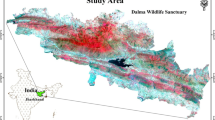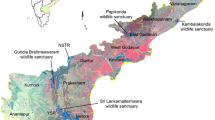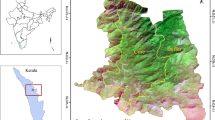Abstract
The hills of Uttarakhand witness forest fire every year during the summer season and the number of these fire events is reported to have increased due to increased anthropogenic disturbances as well as changes in climate. These fires cause significant damage to the natural resources which can be mapped and monitored using satellite images by virtue of its synoptic coverage of the landscape and near real time monitoring. This study presents burnt area assessment caused by the fire episode of April 2016 to the forest vegetation. Digital classification of satellite images was done to extract the burnt area which was found to be 3774.14 km2, representing 15.28% of the total forest area of the state. It also gives an account of cumulative progression of forest fire in Uttarakhand using satellite images of three dates viz. 23rd, 27th May and 2nd June, 2016. Results were analyzed at district, administrative and forest division level using overlay analysis. Separate area statistics were given for different categories of biological richness, forest types and protected areas affected by forest fire. The burnt area assessment can be used in mitigation planning to prevent drastic ecological impacts of the forest fire on the landscape.








Similar content being viewed by others
References
Ankila, H. (2007). Forest fires in India: Extent, justification and policy. In J. Schmerbeck, A. Hiremath & C Ravichandran (Eds.), Fires in Indian forests,Workshop proceedings ATREE, Bangalore, India. Freiburg, Germany:Institute of Silviculture.
Bahuguna, V. K., & Singh, S. (2002). Fire situation in India. International Forest Fire News, 26, 23–27.
Bhandari, B. S., Mehta, J. P. & Semwal, R. L. (2012). Forest fire in Uttarakhand Himalaya: An overview. In G.C.S. Negi, & P.P. Dhyani (Eds.) Glimpses of Forestry Research in the Indian Himalayan Region, Special Issue on International Year of Forests–2011 (pp. 167–175). Almora: G.B. Pant Institute of Himalayan Environment and Development.
Certini, G. (2005). Effects of fire on properties of forest soils: A review. Oecologia, 143(1), 1–10.
Chand, T. K., Badarinath, K. V. S., Prasad, V. K., Murthy, M. S. R., Elvidge, C. D., & Tuttle, B. T. (2006). Monitoring forest fires over the Indian region using Defense Meteorological Satellite Program-Operational Linescan System nighttime satellite data. Remote Sensing of Environment, 103(2), 165–178.
Gubbi S. (2003). Fire, fire burning bright! Deccan Herald, Bangalore, India. http://wildlifefirst.info/images/wordfiles/fire.doc. Accessed January 2004.
Hansen, M. C., Stehman, S. V., & Potapov, P. V. (2010). Quantification of global gross forest cover loss. Proceedings of the National Academy of Sciences, 107(19), 8650–8655.
Inbar, M., Tamir, M. I., & Wittenberg, L. (1998). Runoff and erosion processes after a forest fire in Mount Carmel, a Mediterranean area. Geomorphology, 24(1), 17–33.
Jain, A., Roy, P. S., Ravan, S. A., Singh, R. K., & Das, K. K. (1996). Fire risk modelling using remote sensing and geographic information system. Current Science, 70(10), 928–933.
Jha, C. S., Rajashekar, G., Kiran, Chand T., Singhal, J., Reedy, C. S., Singh, J., et al. (2016). Monitoring of forest fires from Space—ISRO’s initiative for near real time monitoring of recent forest fires in Uttarakhand. Current Science, 110, 2057–2060.
Joseph, S., Anitha, K., & Murthy, M. S. R. (2009). Forest fire in India: A review of the knowledge base. Journal of forest research, 14(3), 127–134.
Koppmann, R., Czapiewski, K. V., & Reid, J. S. (2005). A review of biomass burning emissions, part I: Gaseous emissions of carbon monoxide, methane, volatile organic compounds, and nitrogen containing compounds. Atmospheric Chemistry and Physics Discussions, 5(5), 10455–10516.
Landmann, G., Held, A., Schuck, A. & Van Brusselen, J. (2015). European forests at risk. A scoping study in support of the development of a European Forest Risk Facility. European Forest Institute. https://doi.org/10.13140/RG.2.1.1927.2169
Lentile, L. B., Holden, Z. A., Smith, A. M., Falkowski, M. J., Hudak, A. T., Morgan, P., et al. (2006). Remote sensing techniques to assess active fire characteristics and post-fire effects. International Journal of Wildland Fire, 15(3), 319–345.
Marschall, J. M. (2013). Timber product value loss due to prescribed fire caused injuries in red oak trees. M.S. Dissertation Thesis, Columbia, USA:University of Missouri-Columbia.
Robichaud, P. R. (2000). Fire effects on infiltration rates after prescribed fire in Northern Rocky Mountain forests, USA. Journal of Hydrology, 231, 220–229.
Rothermel, R. C. (1983). How to predict the spread and intensity of forest and range fires. In The Bark beetles, fuels, and fire bibliography (p. 70).
Rowell, A. & Moore, P. F. (2000). Global review of forest fires. Forests for Life Programme Unit, WWF International. Gland, Switzerland:IUCN.
Roy, P. S. (2003). Forest fire and degradation assessment using satellite remote sensing and geographic information system. In Satellite remote sensing and GIS applications in agricultural meteorology (p. 361).
Roy, P. S., Kushwaha, S. P. S., Murhty, M. S. R., Roy, A., Kushwaha, D., Reddy, C. S., Behera, M. D., Mathur, V. B., Padalia, H., Saran, S., Singh, S., Jha, C. S. & Porwal, M. C. (2012). Biodiversity characterization at landscape level: National assessment (p. 140) Indian Institute of Remote Sensing, Dehradun. ISBN 81-901418-8-0.
SFR. (2015). India State of Forest Report. Dehradun: Forest Survey of India.
Singh, R. D., Gumber, S., Tewari, P., & Singh, S. P. (2016). Nature of forest fires in Uttarakhand: Frequency, size and seasonal patterns in relation to pre-monsoonal environment. Current Science, 111(2), 398–403.
Spanos, I., Ganatsas, P., & Tsakaldimi, M. (2010). Evaluation of postfire restoration in suburban forest of Thessaloniki, Northern Greece. Global Nest Journal, 12, 390–400.
The IUCN Red List of Threatened Species. Version 2017-3. www.iucnredlist.org. Downloaded on 02 January 2018.
UNISDR/GE/2015—ICLUX EN5000. (2015). United Nations, Office for Disaster Risk Reduction. Sendai framework for disaster risk reduction 2015–2030 (1st ed.).
Vallejo, R., Hatzistathis, A., Bellot, J. & Serrasolses, I. (2000). Reclamation of Mediterranean Ecosystems affected by wildfires: Forest management recommendations. In P. Balabanis, D. Peter, A. Ghazi, & M. Tsogas (Eds.), Mediterranean desertification. Research results and policy implications (pp. 407–416). Belgium:European Commission
Acknowledgements
The authors acknowledge National Remote Sensing Centre (NRSC), ISRO for providing satellite data and Indian Institute of Remote Sensing for the funding and the laboratory facility to carry out the work.
Funding
Funding was provided by Department of Space, Government of India.
Author information
Authors and Affiliations
Corresponding author
About this article
Cite this article
Gupta, S., Roy, A., Bhavsar, D. et al. Forest Fire Burnt Area Assessment in the Biodiversity Rich Regions Using Geospatial Technology: Uttarakhand Forest Fire Event 2016. J Indian Soc Remote Sens 46, 945–955 (2018). https://doi.org/10.1007/s12524-018-0757-3
Received:
Accepted:
Published:
Issue Date:
DOI: https://doi.org/10.1007/s12524-018-0757-3




